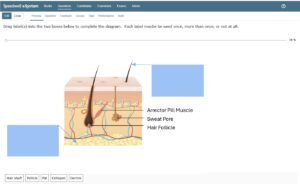- +44 (0)1223 851703
- info@speedwellsoftware.com
The evolving assessment landscape
With technological advancements, exams have transformed in recent years. The days when assessments were limited to paper-based multiple-choice questions and essay responses are gone. As technology has progressed, online exams have evolved with a broader range of question styles that extend beyond traditional multiple-choice. Exam administrators have a range of interactive tools at their disposal, opening up new possibilities for evaluating student knowledge and skills.
The demands of students have changed too. Today’s digital natives expect more, seeking engaging learning experiences that mirror the technology-rich environments they’re accustomed to. Educators are responding to these changing expectations by adopting new question formats. One such format is drag-and-drop questions—an interactive solution that fosters a more engaging and hands-on approach to learning and assessment.
In this blog, we explore the concept of interactive learning with a particular focus on drag-and-drop questions.
The role of interactivity in learning
It’s broadly concluded that interactive learning has positive outcomes for education. Students who are encouraged to participate and engage achieve better results than traditional teaching methods.
Learners can feel disconnected in conventional lectures, where information is delivered verbally with minimal student involvement. In contrast, more collaborative approaches help students feel involved, leading to deeper understanding and improved retention.
Furthermore, students learn skills such as collaboration, communication, flexibility, empathy and initiative. All these skills are vital in preparing them for the workplace and their future careers.
As interactive teaching methods become more commonplace, modern learners who are accustomed to technology and interactivity, will naturally expect assessments to be more dynamic too.
One way to create more interactive assessments is by using question formats that promote engagement, such as drag-and-drop. These types of questions require active involvement from students, leading to a more dynamic and immersive evaluation process.
In the next section, we’ll explore what drag-and-drop questions are, examining how they work and the unique benefits they offer in higher education and medical education environments.
What is a drag-and-drop question and what are the benefits?
A drag-and-drop exam question involves candidates interacting with a set of options by dragging them to designated areas. This type of question format is ideal for tasks like labelling diagrams, making it particularly valuable in medical education.
For example, educators can use medical images, such as X-rays, and ask candidates to identify specific areas, a crucial skill in fields such as surgery, radiology, and anatomy, where practitioners must identify specific areas based on visual cues.
In certain circumstances, this question format is more appropriate than multiple-choice or short-written answers, as it simulates real-world scenarios where doctors examine patients and need to quickly and accurately identify problems. This can promote critical thinking and problem-solving skills.
Unlike other methods, interactive questions stimulate active participation, creating an engaging, and often more realistic, skills-oriented approach to assessment.
Another benefit of drag-and-drop questions is that they can cater to different learning styles, which can enrich the exam experience for students. For example, they could appeal more to students who benefit from a more visual learning approach.
Finally, by adopting more interactive assessment questions, educators demonstrate a commitment to innovative assessment practices. This promotes a positive learning environment and provides students with the confidence that their education is keeping pace with latest educational practices.
What does a Drag and Drop question look like for students?
Assessments, particularly high-stakes assessments can be a stressful experience for students. That’s why, when designing our eSystem exam software, we made it a priority to ensure it’s as user-friendly and intuitive as possible.
When new question styles are introduced the end-user experience is always considered, and the new drag-and-drop question style was no exception.
When taking an exam with drag-and-drop questions, candidates are shown an image along with a set of answer options. They can drag these options into one or more pre-defined drop zones to answer the question. The exact way this works will depend on the question structure and the specific parameters set by the exam administrator. The process is designed to be simple and intuitive for candidates. The image below gives a good example:

The simple design means that students can focus on demonstrating their knowledge rather than struggling with complex interfaces, overall enhancing their exam experience.
Harnessing technology and interactivity for the continual improvement of assessments
Drag-and-drop is only one example Hot spot questions are another. In medical education, OSCE’s could be considered the ultimate example of interactive assessment.
The integration of technology into assessment can enhance the learning experience, contributing to better learning outcomes and deeper understanding. By incorporating interactivity into assessments, you introduce an additional layer that encourages active participation and critical thinking. This not only tests knowledge recall but also challenges students to apply their understanding and organise information in a meaningful way.
Nevertheless, it’s valuable to remember that every question style has its limitations. Including a diverse range of question styles may be the best way to accurately assess a student’s knowledge and skills. This broader approach allows for a more comprehensive evaluation of a candidate’s true knowledge and ability to think critically and analytically.
Ultimately, as technology and teaching methodologies advance, assessment practices must continue to evolve alongside them.










